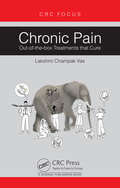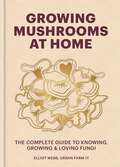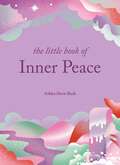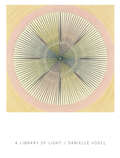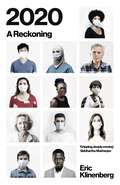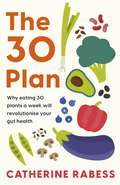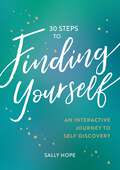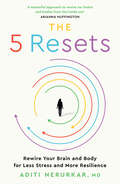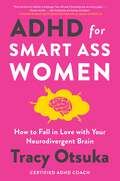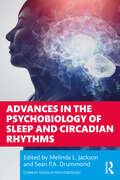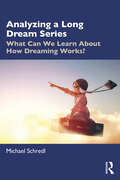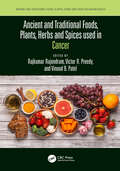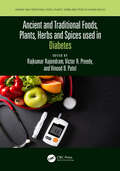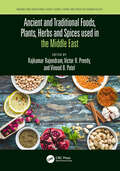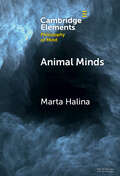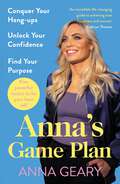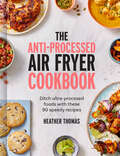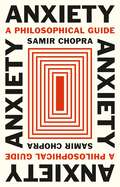- Table View
- List View
Chronic Pain: Out-of-the-box Treatments that Cure
by Lakshmi Champak VasThe book will reassure those suffering from chronic pain and readers that pains can be treated, and not just be ‘managed’. Contemporary pain management comprises some very sophisticated treatments, which address various parts of the nervous system that have been historically assumed to be responsible for pain. The author's approach is that all neuropathic pains are neuromyopathic with a major muscle pain component where the muscles are the final common factor in all chronic pains. This premise led to the innovation of a new system of pain management, which has been gratifyingly effective, providing cures for many complicated conditions. The book is about the discovery that many types of chronic pain are curable and others easily manageable. The novel concepts developed by the author and her research on pain management are described in this book. These are unique, and will be of interest to doctors, researchers, students, and patients.
Chronic Pain: Out-of-the-box Treatments that Cure
by Lakshmi Champak VasThe book will reassure those suffering from chronic pain and readers that pains can be treated, and not just be ‘managed’. Contemporary pain management comprises some very sophisticated treatments, which address various parts of the nervous system that have been historically assumed to be responsible for pain. The author's approach is that all neuropathic pains are neuromyopathic with a major muscle pain component where the muscles are the final common factor in all chronic pains. This premise led to the innovation of a new system of pain management, which has been gratifyingly effective, providing cures for many complicated conditions. The book is about the discovery that many types of chronic pain are curable and others easily manageable. The novel concepts developed by the author and her research on pain management are described in this book. These are unique, and will be of interest to doctors, researchers, students, and patients.
Growing Mushrooms at Home: The Complete Guide to Knowing, Growing and Loving Fungi
by Elliot WebbEverything you need to know to start growing mushrooms at home!Looking for something quick and easy to grow, that doesn't take up much space, and offers numerous health benefits? Then mushrooms are the perfect choice! Growing Mushrooms at Home will take you through all the basics, from key equipment and step-by-step growing guides all the way to how to turn your harvest into teas, coffees and tinctures. These guides can be used for many varieties - including shiitake, lion's mane, wine cap and oyster - and multiple different growing situations, from buckets and bags to outdoor beds and logs.As well as revealing the essential growing know-how, the book explores our long and complex human history with mushrooms and the fascinating ways fungi continues to shape our world. From ancient Aztec rituals and underground tree communication networks to ground-breaking new medicines and organic pesticides, Growing Mushrooms at Home uncovers the weird and wonderful world of mushrooms, and everything they have to offer.
The Little Book of Inner Peace (The Little Book Series)
by Ashley Davis BushA calm mind comes from knowing how you handle your emotions.At its fullest expression, deep inner peace is a response to life - a compassionate, rooted awareness - that is independent of external circumstances. Like the ocean depths, inner peace is expansive and stable. With practice, you can learn to quickly leave the choppy, wild waves at the surface and dive into the calm deep. You can learn to fill your days with the unflappable experience of peace.With beautiful illustrations, and easy exercises, this pocket-sized guide is the perfect book to help you quiet your mind and foster awareness. Inner peace can help you:- Reduce your experience of anxiety, anger, and resentment.- Experience deeper degrees of contentment and calm- Have an awareness that peace is available in the present moment- Experience life with more flow and less resistance- Express more spontaneous gratitude
A Library of Light (Wesleyan Poetry Series)
by Danielle VogelWhen poet Danielle Vogel began writing meditations on the syntax of earthen and astral light, she had no idea that her mother's tragic death would eclipse the writing of that book, turning her attention to grief's syntax and quiet fields of cellular light in the form of memory. Written in elegant, crystalline prose poems, A Library of Light is a memoir that begins and ends in an incantatory space, one in which light speaks. At the book's center glows a more localized light: the voice of the poet as she reflects, with ceremonial patience, on the bioluminescence of the human body, language's relationship to lineage, her mother's journals written during years of estrangement from her daughter, and the healing potential of poetry. A mesmerizing elegy infused with studies of epigenetic theory and biophotonics, A Library of Light shows that to language is to take part in transmission, transmutation of energy, and sonic (re)patterning of biological light.[sample poem]When we are. When we are there, we lay together and cover ourselves with our voices. When we are ten, we are also twenty-one. We speak of breathing, but this is a thing we cannot do. When we are seven, we are also eighteen. When we are eighteen, we begin our bodies. But we are unmappable,unhinged. A resynchronization of codes, thecrystalline frequencies of stars, seeds, vowels, lying dormant within you. We are the oldest dialect. Asound the voice cannot make but makes.
2020: A Reckoning
by Eric KlinenbergRenowned sociologist and best-selling author Eric Klinenberg turns a year of devastation into a year of revelation in this wise, deeply researched and cathartic account of the pandemic.'A gripping, deeply moving account' SIDDHARTHA MUKHERJEE, author of The Song of the CellWhat unites us? What divides us? What do we value? Sociologist Eric Klinenberg had been studying what crises reveal about societies for over two decades when his home of New York became the deadliest hot spot of the global pandemic. In this book he tells the deeply reported stories of seven ordinary people trying to survive at the epicentre of the crisis, and combines them with data gathered from around the world to provide unprecedented insights into what societies are made of, why they come together or fall apart, and how they shape our lives.'Compellingly reveals what the pandemic laid bare about our culture, our institutions, and ourselves' Matthew Desmond, author of Evicted'A book that's at once intimate and far-ranging, that reveals the importance of social solidarity and also its fragility' Elizabeth Kolbert, author of The Sixth Extinction
The 30 Plan: Why eating 30 plants a week will revolutionise your gut health
by Catherine Rabess'The ultimate guide and go-to book for all things gut health, written by an expert' Rhiannon Lambert, BSc MSc RNutr, founder of RhitritionRevolutionise your gut health with this simple plan from an expert dietitianGet on board with the 30 plant challenge! Gut health goes far beyond the stomach - it is linked to how your metabolism, brain and body functions, and even to your mental wellbeing. As much as 70 per cent of your immune system lives in your gut too, so getting it into optimal condition has never been more important. The latest research shows that eating a diverse range of 30 plants a week and getting 30g of fibre a day is the best way to optimise your gut health. This book is the first to combine the two into one simple plan, and will show you just how easy and delicious doing both can be. With 60 mouthwatering recipes and dozens of practical tips and tricks for maximising your intake of plants - fruit, veg, nuts, seeds, legumes, sprouts and more ... - this is the future of plant-based eating. And best of all, it's not restrictive! Expert dietitian Catherine Rabess shows that the key to gut health is diversity, not restriction.
30 Steps to Finding Yourself: An Interactive Journey to Self-Discovery
by Sally HopeThis 30-step journal will take you on a unique journey to discover who you are and who you want to be. With interactive CBT-based activities, journalling prompts and actionable advice to deepen your self-awareness, this book will be your guide to understanding and empowering the most important person in your life: you.
The 5 Resets: Rewire Your Brain And Body For Less Stress And More Resilience
by Dr Aditi NerurkarDiscover how to rethink your relationship with stress and overcome burnout, depression, and anxiety with this accessible health-meets-self-help guide.
ADHD For Smart Ass Women: How to fall in love with your neurodivergent brain
by Tracy OtsukaADHD is one of the most common neurological disorders in the United States - yet a staggering 75 percent of girls and women remain undiagnosed. Due to the gender gap in medical research, which does not account for symptoms manifesting differently in women - leading to increased problems with anxiety, depression, working memory, sleep, energy and concentration - many ADHD women are left to navigate a society that fails to understand their struggles and gifts. But what if every woman had the resources and support to uncover the hidden wonders of her neurodivergent brain?Enter certified ADHD coach and podcast host Tracy Otsuka. Armed with her experience coaching thousands of women, cutting-edge medical research and personal insights from her own diagnosis, she presents a revelatory guide tailored specifically for girls and women with ADHD. In it, Otsuka offers an entirely new set of tools, systems, and strategies to access a world of boundless productivity, focus, and confidence.With her signature wit and levity - in entertaining chapters designed for ADHD readers - Otsuka explores the unique challenges that ADHD women face and illuminates the extraordinary qualities that set them apart: overflowing creativity, laser-focused attention, deep empathy, and fearless entrepreneurial spirit. Even without an official diagnosis, readers will be equipped with the tools to conquer any to-do list and to tap into their true purpose, personally or professionally. Otsuka offers a beacon of hope for any woman looking to transform her symptoms into strengths. Comprehensive, lively and long overdue, ADHD for Smart Ass Women is the key to unlocking unparalleled potential and to understanding your truly magnificent and brilliant brain.
Advances in the Psychobiology of Sleep and Circadian Rhythms (Current Issues in Psychobiology)
by Melinda L. Jackson Sean P.A. DrummondAdvances in the Psychobiology of Sleep and Circadian Rhythms features international experts from the fields of psychobiology, sleep research and chronobiology to address and review cutting-edge scientific literature concerning recent advances in the psychobiology of sleep, sleep disorders, such as sleep apnoea and insomnia, and circadian rhythms, across the lifespan. In this illuminating volume, Melinda L. Jackson and Sean P.A. Drummond bring together leading international researchers to review cross-cutting issues in the field, including sleep and pain, sleep and dementia risk, and sleep issues in paediatric populations as well as the interaction between sleep and health conditions in different populations. The chapters offer coverage of the major explanatory models which underpin the empirical work as well as a discussion of the relevant theoretical and conceptual models on issues arising with specific psychiatric and medical disorders, including depression, dementia, posttraumatic stress disorder and pain. They also address new research in the area of chronobiology, and circadian impacts on health and diseases. The chapters also discuss important methodological and ethical issues arising in research and include sections addressing implications for public policy and practitioner interventions in the context of different social and cultural environments. This volume will be a crucial resource for professionals, practitioners and researchers engaged in the field as well as for postgraduate and upper-level undergraduate students undertaking research in areas related to psychobiology, neuropsychology, health psychology and other disciplines such as biology, physiology and psychopharmacology.
Advances in the Psychobiology of Sleep and Circadian Rhythms (Current Issues in Psychobiology)
Advances in the Psychobiology of Sleep and Circadian Rhythms features international experts from the fields of psychobiology, sleep research and chronobiology to address and review cutting-edge scientific literature concerning recent advances in the psychobiology of sleep, sleep disorders, such as sleep apnoea and insomnia, and circadian rhythms, across the lifespan. In this illuminating volume, Melinda L. Jackson and Sean P.A. Drummond bring together leading international researchers to review cross-cutting issues in the field, including sleep and pain, sleep and dementia risk, and sleep issues in paediatric populations as well as the interaction between sleep and health conditions in different populations. The chapters offer coverage of the major explanatory models which underpin the empirical work as well as a discussion of the relevant theoretical and conceptual models on issues arising with specific psychiatric and medical disorders, including depression, dementia, posttraumatic stress disorder and pain. They also address new research in the area of chronobiology, and circadian impacts on health and diseases. The chapters also discuss important methodological and ethical issues arising in research and include sections addressing implications for public policy and practitioner interventions in the context of different social and cultural environments. This volume will be a crucial resource for professionals, practitioners and researchers engaged in the field as well as for postgraduate and upper-level undergraduate students undertaking research in areas related to psychobiology, neuropsychology, health psychology and other disciplines such as biology, physiology and psychopharmacology.
Analyzing a Long Dream Series: What Can We Learn About How Dreaming Works?
by Michael SchredlAnalyzing a Long Dream Series provides an extraordinary insight into the richness and variability of dreams, considering over 12,000 dreams that have been recorded for more than 30 years. Internationally recognized dream scientist Michael Schredl opens up his own personal dream series, offering a unique window into the interplay between waking life and dreaming. The book considers a huge range of dream topics, including family, friends, schoolmates, colleagues, erotic dreams, alongside the appearance of everyday objects. It also discusses rarer themes such as pain perception, temperature perception, and typical dreams about toilets, exams, and teeth. As the author is both the dreamer and the researcher, questions like why we dream about topics we have never experienced in waking life – for example, about the pain of being shot in the stomach – can be addressed, shedding light on the creative nature of dreams. The in-depth analyses provided in this book attempt to answer the field's most profound questions: why do we dream every night, and why do we dream in such creative ways about the issues that are important to us in waking life? The dreams analyzed question existing dream theories such as simulation theories, and the author proposes a function of recalled dreams for creative problem solving and provides ideas for future research. This fascinating book is an essential read for all dream researchers and students of the psychology of dreams.
Analyzing a Long Dream Series: What Can We Learn About How Dreaming Works?
by Michael SchredlAnalyzing a Long Dream Series provides an extraordinary insight into the richness and variability of dreams, considering over 12,000 dreams that have been recorded for more than 30 years. Internationally recognized dream scientist Michael Schredl opens up his own personal dream series, offering a unique window into the interplay between waking life and dreaming. The book considers a huge range of dream topics, including family, friends, schoolmates, colleagues, erotic dreams, alongside the appearance of everyday objects. It also discusses rarer themes such as pain perception, temperature perception, and typical dreams about toilets, exams, and teeth. As the author is both the dreamer and the researcher, questions like why we dream about topics we have never experienced in waking life – for example, about the pain of being shot in the stomach – can be addressed, shedding light on the creative nature of dreams. The in-depth analyses provided in this book attempt to answer the field's most profound questions: why do we dream every night, and why do we dream in such creative ways about the issues that are important to us in waking life? The dreams analyzed question existing dream theories such as simulation theories, and the author proposes a function of recalled dreams for creative problem solving and provides ideas for future research. This fascinating book is an essential read for all dream researchers and students of the psychology of dreams.
Ancient and Traditional Foods, Plants, Herbs and Spices used in Cancer (Ancient and Traditional Foods, Plants, Herbs and Spices in Human Health)
The use of different foods, herbs, and spices to treat or prevent disease has been recorded for thousands of years. Egyptian papyrus, hieroglyphics and ancient texts from the Middle East have described the cultivation and preparations of herbs and botanicals to “cure the sick.” There are even older records from China and India. Some ancient scripts describe the use of medicinal plants which have never been seen within European cultures. Indeed, all ancient civilizations have pictorial records of different foods, herbs, and spices being used for medical purposes. However, there are fundamental questions pertaining to the scientific evidence for the use of these agents or their extracts in modern medicine. There have been considerable advances in scientific techniques over the last few decades. These have been used to examine the composition and applications of traditional cures. Modern science has also seen the investigation of herbs, spices and botanicals beyond their traditional usage. For example, plants which have been used for “digestion” or “medical ills” since time immemorial are now being investigated for anti-cancer properties or their toxicity, using high throughput screening. Techniques also include molecular biology, cellular biochemistry, physiology, endocrinology and even medical imaging. However, much of the material relating to the scientific basis or applications of traditional foods, herbs, spices and botanicals is scattered among various sources. The widespread applicability of foods or botanicals is rarely described and cautionary notes on toxicity are often ignored. These questions are explored in Ancient and Traditional Foods, Plants, Herbs and Spices used in Cancer. Features · Provides an evidenced-based approach in describing usage and applications of traditional foods and botanicals in prevention and treatment of cancer · Contains chapters on biomedical research related to cancer studies · Discusses extraction and analysis of active agents, in vitro studies, pre-clinical investigations in animals, and clinical studies · Bridges modern day sciences with historical backgrounds related to foods and plants With contributions from leading international experts including those from world renowned institutions, this book is a reference for oncologists, physicians, health scientists, healthcare workers, pharmacologists, and research scientists.
Ancient and Traditional Foods, Plants, Herbs and Spices used in Cancer (Ancient and Traditional Foods, Plants, Herbs and Spices in Human Health)
by Rajkumar Rajendram Victor R. Preedy Vinood B. PatelThe use of different foods, herbs, and spices to treat or prevent disease has been recorded for thousands of years. Egyptian papyrus, hieroglyphics and ancient texts from the Middle East have described the cultivation and preparations of herbs and botanicals to “cure the sick.” There are even older records from China and India. Some ancient scripts describe the use of medicinal plants which have never been seen within European cultures. Indeed, all ancient civilizations have pictorial records of different foods, herbs, and spices being used for medical purposes. However, there are fundamental questions pertaining to the scientific evidence for the use of these agents or their extracts in modern medicine. There have been considerable advances in scientific techniques over the last few decades. These have been used to examine the composition and applications of traditional cures. Modern science has also seen the investigation of herbs, spices and botanicals beyond their traditional usage. For example, plants which have been used for “digestion” or “medical ills” since time immemorial are now being investigated for anti-cancer properties or their toxicity, using high throughput screening. Techniques also include molecular biology, cellular biochemistry, physiology, endocrinology and even medical imaging. However, much of the material relating to the scientific basis or applications of traditional foods, herbs, spices and botanicals is scattered among various sources. The widespread applicability of foods or botanicals is rarely described and cautionary notes on toxicity are often ignored. These questions are explored in Ancient and Traditional Foods, Plants, Herbs and Spices used in Cancer. Features · Provides an evidenced-based approach in describing usage and applications of traditional foods and botanicals in prevention and treatment of cancer · Contains chapters on biomedical research related to cancer studies · Discusses extraction and analysis of active agents, in vitro studies, pre-clinical investigations in animals, and clinical studies · Bridges modern day sciences with historical backgrounds related to foods and plants With contributions from leading international experts including those from world renowned institutions, this book is a reference for oncologists, physicians, health scientists, healthcare workers, pharmacologists, and research scientists.
Ancient and Traditional Foods, Plants, Herbs and Spices used in Diabetes (Ancient and Traditional Foods, Plants, Herbs and Spices in Human Health)
The use of different foods, herbs, and spices to treat or prevent disease has been recorded for thousands of years. Egyptian papyrus, hieroglyphics and ancient texts from the Middle East have described the cultivation and preparations of herbs and botanicals to “cure the sick.” There are even older records from China and India. Some ancient scripts describe the use of medicinal plants which have never been seen within European cultures. Indeed, all ancient civilizations have pictorial records of different foods, herbs, and spices being used for medical purposes. However, there are fundamental issues pertaining to the scientific evidence for the use of these agents or their extracts in modern medicine. These issues are explored in Ancient and Traditional Foods, Plants, Herbs and Spices Used in Diabetes. Features · Investigates alternative healthcare paradigms that use traditional dietary foods, plant-derived materials, and extracts to treat diabetes · Describes scientific studies using modern day biomedical techniques · Provides information on diets, specific agents, extracts and resources. · Many chapters focus on plant-derived material, providing a historical background, uses, toxicity, and cautionary notes and summary points. There have been considerable advances in scientific techniques over the last few decades. These have been used to examine the composition and applications of traditional cures. Modern science has also seen the investigation of herbs, spices and botanicals beyond their traditional usage. Diabetes is one of the most common diseases worldwide, with over 400 million people with the illness. With chapter contributions by an international panel of contributors, this book is useful for researchers in the area of functional foods. Diabetologists, nutritionists, endocrinologists, healthcare workers, and pharmacologists will also find this book extremely valuable.
Ancient and Traditional Foods, Plants, Herbs and Spices used in Diabetes (Ancient and Traditional Foods, Plants, Herbs and Spices in Human Health)
by Rajkumar Rajendram Victor R. Preedy Vinood B. PatelThe use of different foods, herbs, and spices to treat or prevent disease has been recorded for thousands of years. Egyptian papyrus, hieroglyphics and ancient texts from the Middle East have described the cultivation and preparations of herbs and botanicals to “cure the sick.” There are even older records from China and India. Some ancient scripts describe the use of medicinal plants which have never been seen within European cultures. Indeed, all ancient civilizations have pictorial records of different foods, herbs, and spices being used for medical purposes. However, there are fundamental issues pertaining to the scientific evidence for the use of these agents or their extracts in modern medicine. These issues are explored in Ancient and Traditional Foods, Plants, Herbs and Spices Used in Diabetes. Features · Investigates alternative healthcare paradigms that use traditional dietary foods, plant-derived materials, and extracts to treat diabetes · Describes scientific studies using modern day biomedical techniques · Provides information on diets, specific agents, extracts and resources. · Many chapters focus on plant-derived material, providing a historical background, uses, toxicity, and cautionary notes and summary points. There have been considerable advances in scientific techniques over the last few decades. These have been used to examine the composition and applications of traditional cures. Modern science has also seen the investigation of herbs, spices and botanicals beyond their traditional usage. Diabetes is one of the most common diseases worldwide, with over 400 million people with the illness. With chapter contributions by an international panel of contributors, this book is useful for researchers in the area of functional foods. Diabetologists, nutritionists, endocrinologists, healthcare workers, and pharmacologists will also find this book extremely valuable.
Ancient and Traditional Foods, Plants, Herbs and Spices used in the Middle East (Ancient and Traditional Foods, Plants, Herbs and Spices in Human Health)
The use of different foods, herbs, and spices to treat or prevent disease has been recorded for thousands of years. Egyptian papyrus, hieroglyphics and ancient texts from the Middle East have described the cultivation and preparations of herbs and botanicals to “cure the sick.” There are even older records from China and India. Some ancient scripts describe the use of medicinal plants which have never been seen within European cultures. Indeed, all ancient civilizations have pictorial records of different foods, herbs, and spices being used for medical purposes. However, there are fundamental questions and issues pertaining to the scientific evidence for the use of these agents or their extracts in modern medicine. These issues are explored in Ancient and Traditional Foods, Plants, Herbs and Spices used in the Middle East. Features · Describes uses and applications of plant-based materials from different countries of the Middle East. · Each chapter has unique cross references to foods, herbs, spices and botanicals · Bridges molecular biology, physiology and medical sciences · Coverage includes herbal medicines, supplements, lifestyle patterns, nutrition, and plant-based diets · Each chapter describes usage and applications of traditional foods and botanicals; historical background; toxicity; cautionary notes; and summary points There have been considerable advances in scientific techniques over the last few decades. These have been used to examine the composition and applications of traditional cures. Modern science has also seen the investigation of herbs, spices and botanicals beyond their traditional usage. Written by international experts, this is an essential read for food researchers, food scientists, and nutritionists, researchers and health professionals with an interest in the potential therapeutic value of Middle Eastern food components. The book will also be of relevance to physicians and pharmacologists.
Ancient and Traditional Foods, Plants, Herbs and Spices used in the Middle East (Ancient and Traditional Foods, Plants, Herbs and Spices in Human Health)
by Rajkumar Rajendram Victor R. Preedy Vinood B. PatelThe use of different foods, herbs, and spices to treat or prevent disease has been recorded for thousands of years. Egyptian papyrus, hieroglyphics and ancient texts from the Middle East have described the cultivation and preparations of herbs and botanicals to “cure the sick.” There are even older records from China and India. Some ancient scripts describe the use of medicinal plants which have never been seen within European cultures. Indeed, all ancient civilizations have pictorial records of different foods, herbs, and spices being used for medical purposes. However, there are fundamental questions and issues pertaining to the scientific evidence for the use of these agents or their extracts in modern medicine. These issues are explored in Ancient and Traditional Foods, Plants, Herbs and Spices used in the Middle East. Features · Describes uses and applications of plant-based materials from different countries of the Middle East. · Each chapter has unique cross references to foods, herbs, spices and botanicals · Bridges molecular biology, physiology and medical sciences · Coverage includes herbal medicines, supplements, lifestyle patterns, nutrition, and plant-based diets · Each chapter describes usage and applications of traditional foods and botanicals; historical background; toxicity; cautionary notes; and summary points There have been considerable advances in scientific techniques over the last few decades. These have been used to examine the composition and applications of traditional cures. Modern science has also seen the investigation of herbs, spices and botanicals beyond their traditional usage. Written by international experts, this is an essential read for food researchers, food scientists, and nutritionists, researchers and health professionals with an interest in the potential therapeutic value of Middle Eastern food components. The book will also be of relevance to physicians and pharmacologists.
Animal Minds (Elements in Philosophy of Mind)
by null Marta HalinaAnimal minds are complex and diverse, making them difficult to study. This Element focuses on a question that has received much attention in the field of comparative cognition: 'Do animals reason about unobservable variables like force and mental states?' The Element shows how researchers design studies and gather evidence to address this question. Despite the many virtues of current methods, hypotheses in comparative cognition are often underdetermined by the empirical evidence. Given this, philosophers and scientists have recently called for additional behavioral constraints on theorizing in the field. The Element endorses this proposal (known as 'signature testing'), while also arguing that studies on animal minds would benefit from drawing more heavily on neuroscience and biology.
Anna’s Game Plan: Conquer your hang ups, unlock your confidence and find your purpose
by Anna Geary'An incredible life-changing guide to achieving true happiness and success' Kathryn ThomasAs an All-Ireland winning camogie player, Anna Geary learned that the right mindset unlocks everything. It builds confidence, brings success and provides perspective when things don’t go to plan.Sharing the power of mindset has been at the heart of her post-playing career as a speaker, trainer, health and well-being coach and even as a broadcaster.Because daily life is so full-on our mindsets can get disrupted and make us stress about the wrong things. In Anna’s Game Plan, Anna shares the powerful ways that managing your mindset can be life-changing.Based on her extensive experience in nurturing healthy attitudes to mind and body, Anna lays out five practical tactics – Acceptance, Purpose, Consistency, Challenge, Kindness – that can equip you with a practical toolkit to banish overwhelm and focus on what’s really important.Packed with honest relatable stories from Anna’s own life, as well as fascinating insights from the behavioural sciences, Anna’s Game Plan is an essential one-stop guide to building confidence and creating the life you deserve. Change your mindset. Change your life!'Anna's Game Plan will help you to be the best version of you' Karl Henry
The Anti-Processed Air Fryer Cookbook: Ditch Ultra-processed Food With These 90 Speedy Recipes
by Heather ThomasFrom healthy breakfast options to delicious family favourite meals, snacks and desserts, The Anti-Processed Air Fryer Cookbook has simple recipes to satisfy every craving.
Anxiety: A Philosophical Guide
by Samir ChopraHow philosophy can teach us to be less anxious about being anxious by understanding that it&’s an essential part of being humanToday, anxiety is usually thought of as a pathology, the most diagnosed and medicated of all psychological disorders. But anxiety isn&’t always or only a medical condition. Indeed, many philosophers argue that anxiety is a normal, even essential, part of being human, and that coming to terms with this fact is potentially transformative, allowing us to live more meaningful lives by giving us a richer understanding of ourselves. In Anxiety, Samir Chopra explores valuable insights about anxiety offered by ancient and modern philosophies—Buddhism, existentialism, psychoanalysis, and critical theory. Blending memoir and philosophy, he also tells how serious anxiety has affected his own life—and how philosophy has helped him cope with it.Chopra shows that many philosophers—including the Buddha, Kierkegaard, Nietzsche, Freud, and Heidegger—have viewed anxiety as an inevitable human response to existence: to be is to be anxious. Drawing on Karl Marx and Herbert Marcuse, Chopra examines how poverty and other material conditions can make anxiety worse, but he emphasizes that not even the rich can escape it. Nor can the medicated. Inseparable from the human condition, anxiety is indispensable for grasping it. Philosophy may not be able to cure anxiety but, by leading us to greater self-knowledge and self-acceptance, it may be able to make us less anxious about being anxious.Personal, poignant, and hopeful, Anxiety is a book for anyone who is curious about rethinking anxiety and learning why it might be a source not only of suffering but of insight.
Anxiety: A Philosophical Guide (Moral Psychology Of The Emotions Ser.)
by Samir ChopraHow philosophy can teach us to be less anxious about being anxious by understanding that it&’s an essential part of being humanToday, anxiety is usually thought of as a pathology, the most diagnosed and medicated of all psychological disorders. But anxiety isn&’t always or only a medical condition. Indeed, many philosophers argue that anxiety is a normal, even essential, part of being human, and that coming to terms with this fact is potentially transformative, allowing us to live more meaningful lives by giving us a richer understanding of ourselves. In Anxiety, Samir Chopra explores valuable insights about anxiety offered by ancient and modern philosophies—Buddhism, existentialism, psychoanalysis, and critical theory. Blending memoir and philosophy, he also tells how serious anxiety has affected his own life—and how philosophy has helped him cope with it.Chopra shows that many philosophers—including the Buddha, Kierkegaard, Nietzsche, Freud, and Heidegger—have viewed anxiety as an inevitable human response to existence: to be is to be anxious. Drawing on Karl Marx and Herbert Marcuse, Chopra examines how poverty and other material conditions can make anxiety worse, but he emphasizes that not even the rich can escape it. Nor can the medicated. Inseparable from the human condition, anxiety is indispensable for grasping it. Philosophy may not be able to cure anxiety but, by leading us to greater self-knowledge and self-acceptance, it may be able to make us less anxious about being anxious.Personal, poignant, and hopeful, Anxiety is a book for anyone who is curious about rethinking anxiety and learning why it might be a source not only of suffering but of insight.
